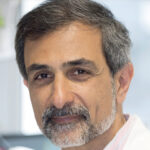Link to Pubmed [PMID] – 19531352
Dev. Cell 2009 Jun;16(6):810-21
Genetic regulatory networks governing skeletal myogenesis in the body are well understood, yet their hierarchical relationships in the head remain unresolved. We show that either Myf5 or Mrf4 is necessary for initiating extraocular myogenesis. Whereas Mrf4 is dispensable for pharyngeal muscle progenitor fate, Tbx1 and Myf5 act synergistically for governing myogenesis in this location. As in the body, Myod acts epistatically to the initiating cascades in the head. Thus, complementary pathways, governed by Pax3 for body, and Tbx1 for pharyngeal muscles, but absent for extraocular muscles, activate the core myogenic network. These diverse muscle progenitors maintain their respective embryonic regulatory signatures in the adult. However, these signatures are not sufficient to ensure the specific muscle phenotypes, since the expected differentiated phenotype is not manifested when satellite cells are engrafted heterotopically. These findings identify novel genetic networks that may provide insights into myopathies which often affect only subsets of muscles.

